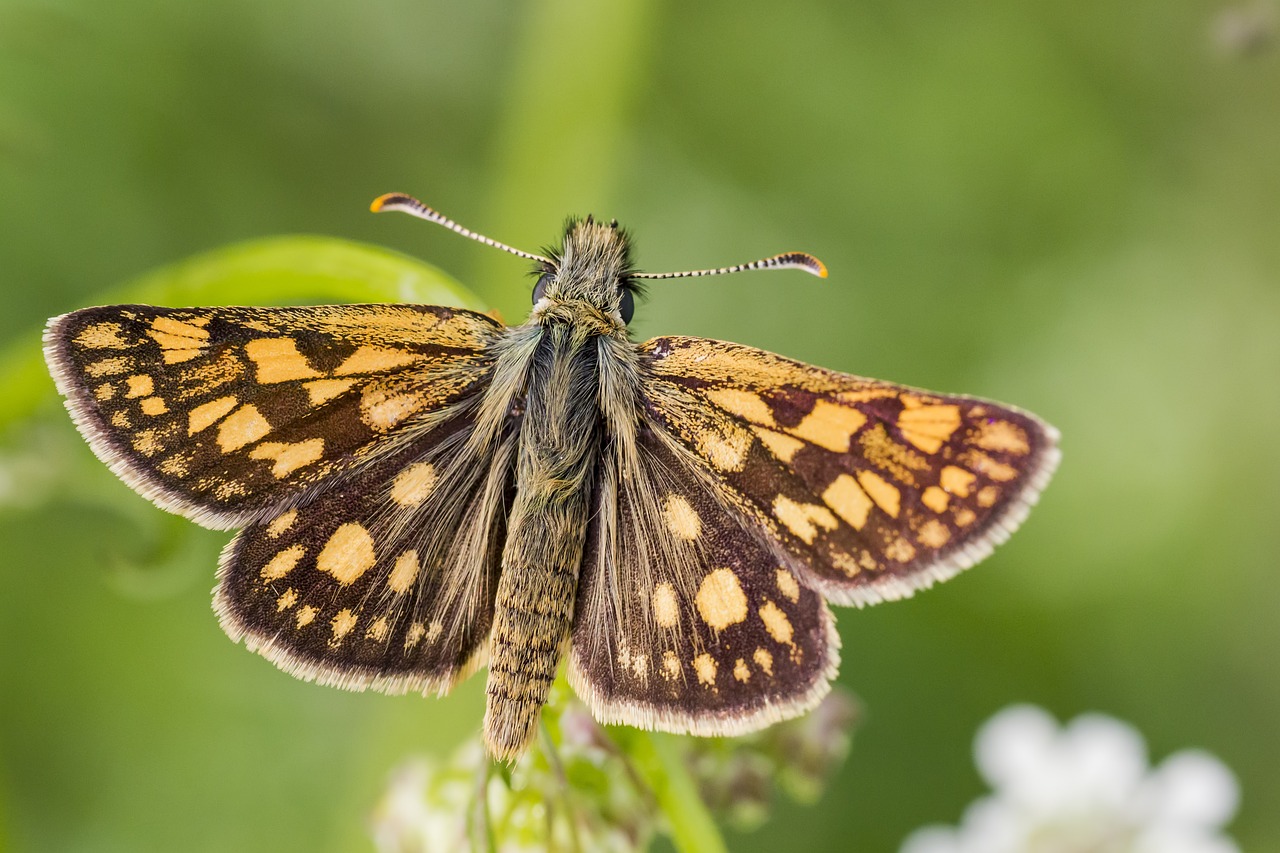The Chequered Skipper (Carterocephalus palaemon) is a small butterfly belonging to the family Hesperiidae. Here are some key features and characteristics of the Chequered Skipper:
Appearance
- Size: The Chequered Skipper has a wingspan of about 25 to 30 millimeters (1 to 1.2 inches).
- Color and Pattern: The upper side of the wings is dark brown with a distinctive pattern of orange-yellow spots arranged in a chequered pattern, hence its name. The underside of the wings is brown with cream-colored spots and a distinct white central spot on the hindwing.
Habitat
- Chequered Skippers are typically found in damp, grassy areas, often in woodland clearings, glades, and along woodland rides. They prefer habitats that have a mix of grasses and flowers, particularly in areas with moist conditions.
Distribution
- The Chequered Skipper is found across parts of Europe and Asia. In Europe, its range includes the United Kingdom, where it is primarily found in Scotland. Its distribution extends through parts of northern and central Europe, into Asia including Japan. The species has a fragmented distribution and is locally abundant in suitable habitats.
Behavior
- Flight Period: The Chequered Skipper typically flies from late May to early July, depending on the climate and geographic location. They are most active during sunny, warm days.
- Feeding: Adults feed on nectar from a variety of flowers, including bugle (Ajuga), buttercups (Ranunculus), and bluebells (Hyacinthoides). The larvae feed on grasses, particularly purple moor-grass (Molinia caerulea) and wood small-reed (Calamagrostis epigejos).
Life Cycle
- Eggs: Females lay eggs singly on the leaves of host plants.
- Larvae (Caterpillars): After hatching, the caterpillars feed on the host plants. They create shelters by spinning leaves together with silk. The larvae are green with a dark head and white lines along the sides.
- Pupae (Chrysalis): The caterpillars pupate within their shelters. The pupal stage lasts for a few weeks before emerging as adult butterflies.
- Adults: Adults emerge in late spring to early summer. They are active for a few weeks, during which they feed, mate, and lay eggs.
Conservation Status
- The Chequered Skipper is considered vulnerable in some parts of its range, particularly in the United Kingdom, where it has experienced significant declines due to habitat loss and changes in land management practices. Conservation efforts focus on habitat restoration and management to maintain suitable conditions for this species.
Interesting Facts
- The Chequered Skipper was once more widespread in England but became extinct there in the mid-20th century. It is now primarily found in Scotland.
- The butterfly’s flight is characterized by a rapid, darting pattern, typical of skippers.
- Conservation programs, including reintroduction projects, have been initiated to restore populations in areas where they have declined.
In summary, the Chequered Skipper (Carterocephalus palaemon) is a small, distinctively patterned butterfly that inhabits damp, grassy woodlands and clearings. Its conservation is important due to its fragmented distribution and vulnerability to habitat changes.
Estonia is home to a variety of butterflies, thanks to its diverse habitats ranging from forests and meadows to wetlands and coastal areas. Some notable butterflies found in Estonia include:
Common Butterflies:
- Peacock Butterfly (Inachis io): Recognizable by its striking eyespots on the wings, this butterfly is commonly seen in gardens and woodlands during late summer and early autumn.
- Painted Lady (Vanessa cardui): Known for its orange and black-patterned wings, this migratory butterfly is often spotted in meadows and gardens.
- Small Tortoiseshell (Aglais urticae): Featuring bright orange and black patterns with blue spots, it frequents gardens, meadows, and open woodlands.
- Comma Butterfly (Polygonia c-album): Named for the comma-shaped mark on its hind wings, it is found in woods and gardens, especially in late summer and autumn.
- Cabbage White (Pieris rapae): This common butterfly has white wings with black spots and is often seen in gardens, particularly where cabbage and other Brassicaceae plants are growing.
Forest and Woodland Butterflies:
- Purple Emperor (Apatura iris): This large butterfly has a striking purple sheen on its wings and is found in mature broadleaved forests.
- Silver-washed Fritillary (Argynnis paphia): With its orange wings and silver underside, it frequents woodland clearings and sunny areas.
- Brimstone (Gonepteryx rhamni): Recognizable by its bright yellow wings, this butterfly can be found in hedgerows and woodlands.
Meadow and Grassland Butterflies:
- Meadow Brown (Maniola jurtina): This butterfly is commonly seen in grassy meadows and fields, with its brown wings featuring orange spots.
- Common Blue (Polyommatus icarus): A small butterfly with vibrant blue wings, often found in meadows and grassy areas.
- Skipper Butterflies (Hesperiidae): Various species, such as the Large Skipper (Ochlodes sylvanus), are present in grasslands and meadows.
Wetland Butterflies:
- Swallowtail (Papilio machaon): The largest butterfly in Europe, it is occasionally found in wetland areas where its larval food plants are present.
- Marsh Fritillary (Euphydryas aurinia): A butterfly that prefers damp meadows and marshes, it has distinctive orange and black markings.
Estonia’s butterfly fauna is diverse, reflecting the country’s varied habitats. The changing seasons also bring different species into view, making butterfly watching a rewarding activity throughout the year.
Views: 1043
Subscribe to the newsletter:
